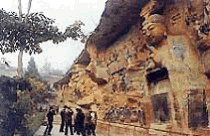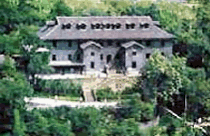Chongqing
Chongqing is essentially a mountainous city, surrounded on all sides by steep hills which keep the fog and mist in the basin. The Yangtze and Jialing Rivers embrace the downtown area here however, providing light relief from the industrial city views prevalent throughout most of the area. With 300 developed scenery spots, Chongqing altogether owns 1300 scenery spots, including 4 nationwide important spots, 6 national cultural relic protection units and 1100 municipal cultural relic protection units.
Chongqing is essentially a mountain city, surrounded on all sides by steep hills which keep the fog and mist in the basin. The Yangtze and Jialing Rivers embrace the downtown area here however, providing light relief from the industrial city views prevalent throughout much of the area.
Chongqing has a couple of names. Houses and apartment blocks built halt way up mountains from an undulating pattern, Chongqing is, therefore, called "The Mountain City". Standing at the confluence of the Jialing and Yangtze rivers, it is thus called "The River Town "as well. Surrounded by mountains. The city is subtropical, hot in summer. Hence it is sometimes called "The Furnace". The average annual precipitation is about l,000 millimeters and most of them concentrated on the nights from May to October. As a result, there emerged such a much quoted line: Night Raining on the Ba Mountains. Owing to the plenty of raining, the air humidity is often as high as over 80 percent, so the weather conditions are often cloudy and misty. In such a case, the place is also known as "a city of fog".
Ever since the move of the State Council being approved on March 14, 1997 by the fifth session of the Eighth National People's Congress, Chongqing has become the fourth municipality directly under the Central Government, together with Beijing, Shanghai and Tianjin. As the largest city of China, Chongqing covers an area of 82,400 square kilometres with a population of 3002 million. Belonging originally to Sichuan Province, Wanxian municipality, Fuling Municipality and Qianjiang District are now under Chongqing's jurisdiction. A great part of the Three Gorges appear now in the territory of Chongqing. So, apart from many historical relics and tourist attractions, such as the Ghost City of Fengdu, Stone Treasure Block, The Zhang Fei Temple and White Emperor City, the 6,000 meter long dam area adds much lustre to Chongqing. Besides, there are many other invaluable relics, such as a fossil of caveman two million years old unearthed at Longping Village in Wushan County, a Palaeolithic site excavated recently at Yandengbo in Fengdu, a Warring- States-Period site located at Xiaotianxi in Zhecheng, a Han dynasty grave ground situated at Weinan in Fengdu County and a national-grade underwater forest of stone tablets situated in Baiheliang, provide valuable information for a study of the material life and social nature of this place during the ancient times.
With 300 developed scenery spots, Chongqing altogether owns 1300 scenery spots, including 4 nationwide important spots, 6 national cultural relic protection units and 1100 municipal cultural relic protection units.
Recommended Scenic Spots
The Dazu Grottoes
Over 60,000 carved stone figures relating mainly to Buddhism are spread around 76 places within Dazu County, 160 kilometers to the west of Chongqing. The content and craftsmanship are best at Beishan and Baoding Hills. The art of Dazu that emerged in the late Tang Dynasty (618-907AD) and flourished in the Song Dynasty (960-1127) represents an important chapter in China's cultural and religious history.
Dynasty (960-1127) represents an important chapter in China's cultural and religious history.
Beishan (or Gulonggang Hill) has 290 shrine caves in all. The most well-known of them is the Xinshenche (the Wheel of the Universe) Cave. In the center shrine stands the Buddha, with jingbaobing Guanyin (a kind of Buddha) at the left side and Duoluo at the right side. In the left shrine there stand Manjusri, yuyin Guanyin and ruiyizhu Guanyin. In the right shrine there stand Samantabhadra, riyue Guanyin and suzhushou Guanyin. They are created in a symmetrical manner and proper order, as though they were an integral whole. The eight statues of Bodhisattvas have the features of well-proportioned bodies, exquisitely luxurious garments and distinct characters.
Baoding (Treasure Peak) Mountain, fifteen kilometers northeast of Dazu, is well-known for its comprisal of more than ten thousand magnificent sculptures. Those located in Dafowan are best preserved and most numerous. Dafowan is a U-shaped range of hills about fifteen to thirty meters high and some five hundred meters long. The statue carved on the eastern, southern and northern cliffsides of the valley are patterned in accordance with the terrain of the hills, resulting in natural and magnificent structure. Consisted of more than 15,000 stone sculptures in 19 groups of the Buddhist stories, the statues in this grotto look so marvelous that each of them is portrayed in different pose and with a different expression. They are worth appreciating. The Yuan Jue (Total Awakening) Grotto at the hilltop was created in a whole rock, so it is quite spacious. In the center of the cave stand three Buddhas. In front of the main Buddha stands a knelling Bodhisattva with his head down and his palms put together with reverent attention. On the either side before the wall there stand twelve Bodhisattvas who sit cross-legged on a lotus throne striving to attain enlightenment. The reining cave walls are carved into temples, trees, mountains, flowers, and heavenly and earthly beings.
In the treasure of Dazu stone sculptures, the well designed groups of nineteen grand relieves cover a wide scope of artistic themes, and most of them present Buddhist figures as human beings and depict scenes from everyday life. They are rarely seen in any other part of the world.
The special cultural atmosphere makes the boom of folk sculpture art in Dazu. As a result, in addition to a great variety of the artistic works, all of the products, such as stone lion, stone inkslab and stone statue of Buddha, are quite delicate and vivid.
Hongyan Cun (the Red Crag Village)
During the Kuomintang-Communist alliance against the Japanese during WWII, the Red Crag Village outside Chongqing was used as the offices and living quarters of the Communist representatives to the Kuomintang. Many famous leaders, such as Zhou Enlai, Ye Jianying, Deng Yingchao once stayed here. On August 28th, 1945, Mao Zedong had stayed in this place when he came to Chongqing to negotiate with Ching Kai-shek.
came to Chongqing to negotiate with Ching Kai-shek.
There are many historical relics here: the Guiyuan, the right place where Mao Zedong put down his signature on the agreement of negotiation and where he met the personages of various circles; No.50, one of Zhou Enlai's important offices during that period; the former residence of Sun Yat-sen; the living quarters for General Stilwell and General Marshall; the official mansion of Chiang Kai-shek, and so on.













No comments:
Post a Comment